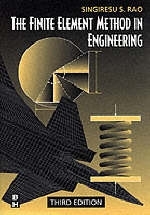
The Finite Element Method in Engineering
Seiten
1999
|
3rd edition
Butterworth-Heinemann Ltd (Verlag)
978-0-7506-7072-2 (ISBN)
Butterworth-Heinemann Ltd (Verlag)
978-0-7506-7072-2 (ISBN)
- Titel erscheint in neuer Auflage
- Artikel merken
Zu diesem Artikel existiert eine Nachauflage
The finite element method of analysing and modelling structures and forms is based on turning physical shapes into mathematical models made up from descriptive nodes. The author here explains the topic from first principles.
With the revolution in readily available computing power, the finite element method has become one of the most important tools for the modern engineer. This method of analyzing and modeling materials, structures, and forms is based on turning physical shapes into mathematical models made up from descriptive nodes, which can be manipulated using matrix methods. Examples include the new discipline of computational fluid dynamics, aerodynamic modeling, and the prediction of the behavior of components under load. The nature of matrix algebra means that these calculations can easily be performed using computer programs, thus making enormous savings in time and efficiency.
It is vital that the engineer or engineering student fully understands the theory and knowledge that underpins the finite element method before it is possible to utilize it in practice. Professor Rao, who has many years of teaching experience at one of the country's leading centers of technical excellence, explains the topics from first principles, making use of numerous illustrations and examples and breaking the subject into easily absorbed segments which will guide the reader through the material in stages.
With the revolution in readily available computing power, the finite element method has become one of the most important tools for the modern engineer. This method of analyzing and modeling materials, structures, and forms is based on turning physical shapes into mathematical models made up from descriptive nodes, which can be manipulated using matrix methods. Examples include the new discipline of computational fluid dynamics, aerodynamic modeling, and the prediction of the behavior of components under load. The nature of matrix algebra means that these calculations can easily be performed using computer programs, thus making enormous savings in time and efficiency.
It is vital that the engineer or engineering student fully understands the theory and knowledge that underpins the finite element method before it is possible to utilize it in practice. Professor Rao, who has many years of teaching experience at one of the country's leading centers of technical excellence, explains the topics from first principles, making use of numerous illustrations and examples and breaking the subject into easily absorbed segments which will guide the reader through the material in stages.
Introduction to Finite Element Method: Solution to Finite Element Equations; General Procedure of Finite Element Method; Higher Order and Isoparametric Element Formulations; Solid and Structural Mechanics; Heat Transfer; Fluid Mechanics; Additional Applications and Generalizations; Appendix; Index
| Erscheint lt. Verlag | 5.1.1999 |
|---|---|
| Zusatzinfo | Approx. 250 illustrations; Illustrations, unspecified |
| Verlagsort | Oxford |
| Sprache | englisch |
| Maße | 178 x 254 mm |
| Gewicht | 960 g |
| Themenwelt | Mathematik / Informatik ► Mathematik ► Algebra |
| Mathematik / Informatik ► Mathematik ► Angewandte Mathematik | |
| Mathematik / Informatik ► Mathematik ► Geometrie / Topologie | |
| ISBN-10 | 0-7506-7072-X / 075067072X |
| ISBN-13 | 978-0-7506-7072-2 / 9780750670722 |
| Zustand | Neuware |
| Informationen gemäß Produktsicherheitsverordnung (GPSR) | |
| Haben Sie eine Frage zum Produkt? |
Mehr entdecken
aus dem Bereich
aus dem Bereich
Buch | Softcover (2022)
Springer Spektrum (Verlag)
CHF 55,95



